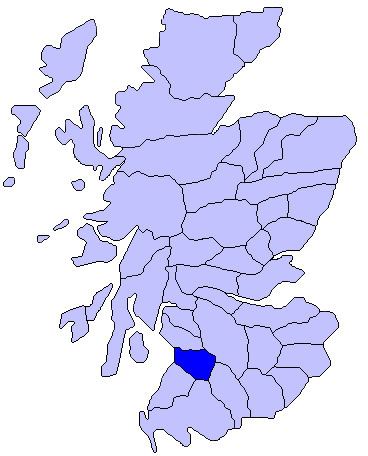 | ||
Kyle (or Coila poetically; Scottish Gaelic: Cuil) is a former comital district of Scotland which stretched across parts of modern-day East Ayrshire and South Ayrshire. It is said to be named after Coel Hen, a king of the Britons, who was reputedly killed in battle in this area and is said to be buried in a cairn near Mauchline. Kyle is also a popular name with its origins meaning straight or narrow.
Contents
Geographical Extent
The area was bordered by the historical districts of Cunninghame to the north, Clydesdale to the east and by Carrick to the south. The Firth of Clyde lies to the west.
Kyle was the central of the three districts in the sheriffdom of Ayr, which was divided naturally by its three primary rivers all running in a generally westward direction to flow into the firth of Clyde. The River Irvine formed the northern boundary of Kyle with Cunninghame; the River Doon established its southern boundary with Carrick. Additionally, Kyle itself was sub-divided into two parts. To the north of the River Ayr was "Kyle Stewart" (sometimes called "Stewart Kyle" or "Walter's Kyle"), lands held by the FitzAlans (the future Stewart Kings of Scotland) since the 12th century. To the south was "Kyle Regis" or "King's Kyle", lands historically retained by the monarch under royal authority from the royal castle at Ayr. (On 16 May 1975 Ayr County Council officially disbanded these old districts and burghs.)
Kyle was eventually combined with Cunninghame and Carrick into the county of the Shire of Ayr during reorganisation due to Local Government (Scotland) Act 1889; this Act established a uniform system of county councils and town councils in Scotland and restructured many of Scotland’s areas.
Kyle and Carrick District
From 1975 to 1996 Kyle and Carrick was the name of a local government district in Strathclyde region, although the larger part of historic Kyle formed Cumnock and Doon Valley district. In 1996 Kyle and Carrick was constituted as a Unitary Authority, but renamed South Ayrshire.
Council ward
In local government the area of Kyle makes up a council ward, bordering the council wards of Troon, Prestwick, Ayr North and Maybole, North Carrick & Coylton. It has 3 local councillors belonging to the Labour Party, the Scottish National Party and the Conservative Party. The area of Kyle includes the villages of Tarbolton. Mossblown, Symington and Dundonald as well as a number of smaller surrounding settlements such as Craigie, St Quivox and Loans. the area effectively encompasses the northern portion of South Ayrshire excluding Troon, Prestwick and Ayr. It is bounded by the northern and eastern borders of the South Ayrshire which border North and East Ayrshire respectively. The southern border of the area follows the B743 until reaching Brockle Wood - which the borders cut through before following the B744: thus avoiding Annbank. It then follows the B742 to the River Ayr. The rest of the border is marked by the River Ayr. The total population of the area was 11,573 according to the 2011 census.
Kyle Castle
Near Cumnock, at the confluence of Guelt and Glenmuir Waters, lie the ruins of the 15th century Kyle Castle.
